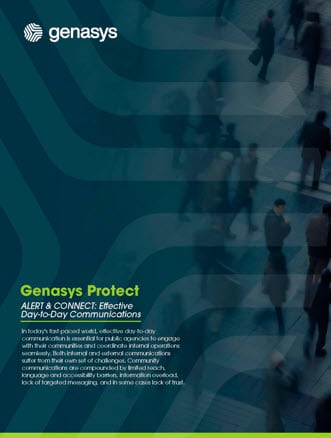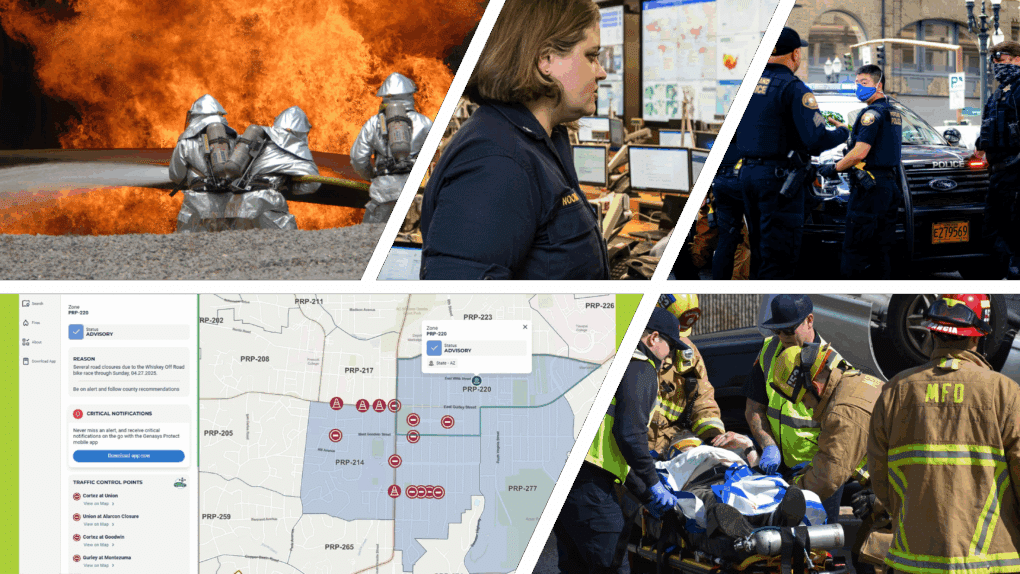by Richard Danforth, Genasys CEO
All evacuations entail risk, but not evacuating people in the event of a disaster is not an option. However, there are things we can do to minimize risk to first responders and to the public that can occur during evacuations. These include adopting proactive measures that are supported by a new generation of Protective Communications solutions designed to make evacuation management easier, more efficient and safer.
These tools differ from legacy critical event management systems, which are reactive by nature, in that they include features such as flexible zone-based planning and decision making, a unified operating picture, and granular, multi-channel alerting capabilities. Let’s cover each of these features and their benefits in turn.
Flexible Zone-Based Planning and Decision Making
First off, what are zones? They are a way to divide jurisdictions, enabling emergency managers and first responders to more easily and rapidly refer to specific locations in the preparation and implementation of evacuations and other crisis responses. Zones and the areas they contain can be promoted on Know Your Zone to the general public and the media as a means for all to quickly and easily see what is taking place, what zones are affected during an emergency, and whether they need to evacuate.
In flexible zone-based planning and decision making, emergency managers can use zones to consider evacuation management from both holistic and granular perspectives. This technique enables them to better understand how the movement of people in each zone will help or hinder the overall evacuation process. Its flexibility enables emergency managers to subdivide zones on the fly, which produces benefits that I’ll describe throughout this piece.
Zone-based planning enables predictive simulation – an essential capability that emergency managers can rely on to anticipate how and where a critical event is going to impact the jurisdiction and what kind of response is going to be most effective in keeping people safe. In some circumstances, managers may decide to subdivide zones to focus their resources, communicate precisely with the members of the public that need specific information or instructions, and orchestrate a more efficient response overall.
Emergency managers can also use predictive simulation to model the impact of an evacuation on infrastructure and resources to better understand traffic volume, evacuation routes, weather and more. This allows emergency managers to optimize evacuation plans before they are executed to ensure people will be able to move out of the area safely.
Then, when an actual emergency arises, managers can use these models to make precise calls when it’s time to evacuate specific zones. They can coordinate evacuation of neighborhoods by block to ensure traffic moves unrestricted to avoid bottlenecks, which can trap people in vehicles and prevent first responders from getting to the scene.
In this way, zone-based planning and decision making empowers emergency managers to consider a range of scenarios before they execute their evacuation plan. This, in turn, allows for nuanced and effective evacuations during a critical event to maximize safety of all involved.
Unified Operating Picture
A unified operating picture helps emergency managers ensure that their entire team is on the same page during a critical event. Likewise, it also enables emergency managers and first responders from neighboring jurisdictions to coordinate responses. Wildfires and other large scale disasters frequently occur across jurisdictional borders or require assistance from neighboring agencies, making a shareable, unified operating picture an essential part of a modern emergency management program.
Without the ability to share information in real time, emergency managers and first responders from different units lack a vital tool that allows them to quickly grasp the what and where of the situation. A unified operating picture enables emergency managers to make rapid, informed evacuation decisions, establish consensus, ensure that everyone knows what they need to do and where to go, and to decide how best to subdivide zones if conditions warrant.
This avoids situations where emergency managers and first responders see different threats in the same emergency and lose the ability to coordinate evacuations, leading to loss of time and, potentially, life.
Granular Multi-Channel Alerting
Once evacuation decisions have been made, emergency managers must ensure that entire communities of people are aware of those decisions and how they uniquely affect each individual. Granular, multi-channel alerting capabilities enable emergency managers to get the right information to the right people at the right time.
This requires a technological shift from sending mass notifications to sending differentiated notifications. Differentiated notifications are customized alerts that address a specific zone or sub-zone and are tailored to a unique audience. When combined with flexible zone-based planning and decision making, people receive timely, targeted, relevant messages that include information specific to them.
In the most recent of our series of posts covering National Preparedness Month, I discussed how granular, multi-channel alerting and Genasys Protect ALERT foster community engagement to improve public safety and maximize the public’s investment in their own protection. We know that not everyone follows the same sources of news and information. This makes it essential to deploy a solution that provides multi-channel alerting capabilities to disperse evacuation instructions across multiple devices and platforms including email, text (SMS), social media, phone, television, radio, digital signage, as well as the public-facing Genasys Protect website and mobile app.
By providing the public with multiple simple ways to check the status of critical and non-emergency events and consistently delivering the right message to the right people at the right time, people appreciate their emergency response agencies and see them as a source of correct, actionable information.
Multi-channel alerting can also incorporate acoustic devices that broadcast highly audible voice messaging over long distances. This provides an additional means to reach people who may not carry smart phones or other devices. These remotely operated, independently powered loudspeakers are described more in the first of our series of National Preparedness Month posts.
Bringing Them All Together
Each one of these features and capabilities – flexible zone-based planning and decision making, a unified operating picture, and granular, multi-channel alerting capabilities – builds on the other. That’s why we’ve combined all of them into our flagship Protective Communication offering: Genasys Protect, which comprises three distinct but tightly integrated solutions.
- Genasys Protect EVAC provides the simulation and orchestration capabilities needed to plan and execute efficient evacuations.
- Genasys Protect ALERT provides the granular, multi-channel alerting capabilities to get specific instructions to affected members of the community or jurisdiction by specific zone.
- Genasys Protect ACOUSTICS deliver highly audible info and instructions over remotely operated and auxiliary powered outdoor warning systems and loudspeakers to augment multi-channel notification and reach people who haven’t otherwise received the word.
Just as it takes a full crew to put out a fire – each member supporting each other and the entire effort – it takes a full complement of unique tools to enable emergency managers to properly plan for and execute evacuations. That is why replacing legacy mass notification systems and reactive measures with a proactive posture toward emergency response and evacuation management pays off in lives saved and intact communities.

















